
Introduction
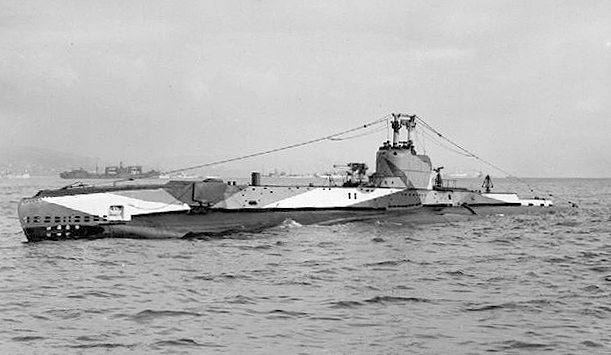
British submarines during WW2 were never given the same focus as for surface vessels, and despite heavy losses in 1940-1941, mostly due to the use of large oceanic types in the Mediterranean, wartime production focused on smaller types pioneered before the war, like the Oceanic T class, and the coastal S and U classes. The latter found better use against the Regia Marina and axis convoys in general, and inverted the balance. They contributed considerably to hamper the capabilities of the axis to take Malta or supply the Afrika Korps. Production of submarine came to a standstill in 1944, and most were re-affected in the far east. The last oceanic type, the A class in 1944, formed the basis for early cold war designs.
Development
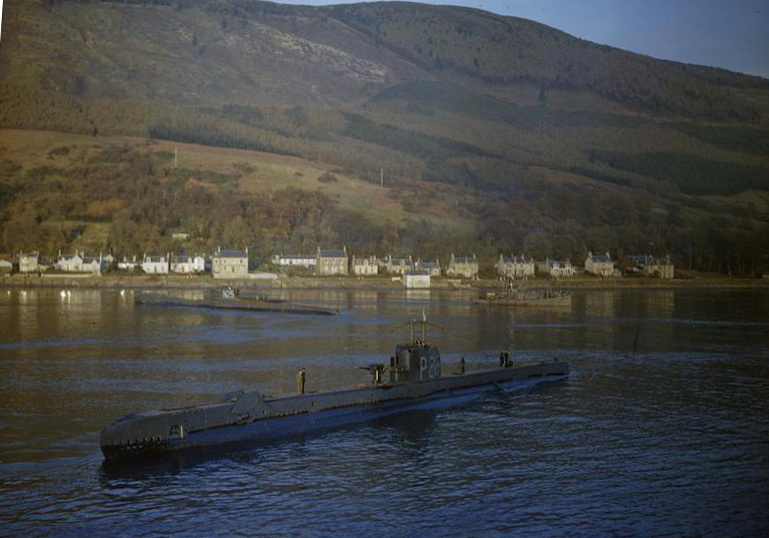
HMS Thetis in Scotland, 1942
Development of British submersibles went a long way since 1899 and the first American Holland type made under licence by Vickers; In 1920 they had one of the largest operational submersible fleet, despite being a naval asset long despises by British naval conservative circles. The last classes, H and L of 1918-1920 were still very much still influenced by the American designs, great speed and agility underwater but poorer performances on surface, although other types were developed during the war, like the K and J class. Most were discarded during the interwar, but of the L class, most were still active when WW2 broke out, as training submersibles and for western approach patrols. There were basically two types of submersibles in service during the interwar, ancient to newly built:
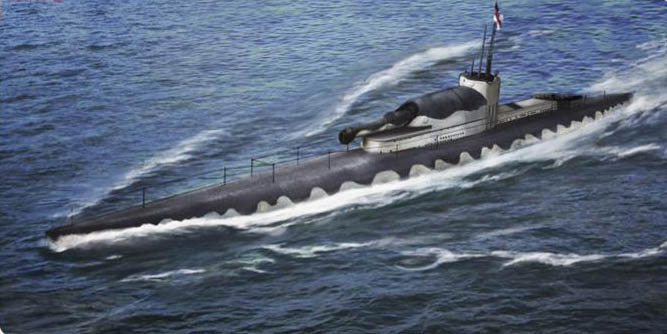
An M-class submersible (1918) as seen in 1924, testing a naval camouflage. She was lost the next year in a collision.
-The cruiser types: M1 of the M class was only one to enter service in WW1. M2 and M3 were converted as seaplane carriers and the fourth was cancelled. She was the largest class of submarines in service with the Royal Navy until 1932, two were lost in 1925 and 1932 and the third scrapped also in 1932. The K class were discarded in 1921-24, and the only interwar type built (see below) was the interesting X1 (1923). The Washington treaty in 1922 forbidden such large cruiser submersibles that can circumvent gunnery and range limitations. The French with their interwar Surcouf retook the lead in that area.
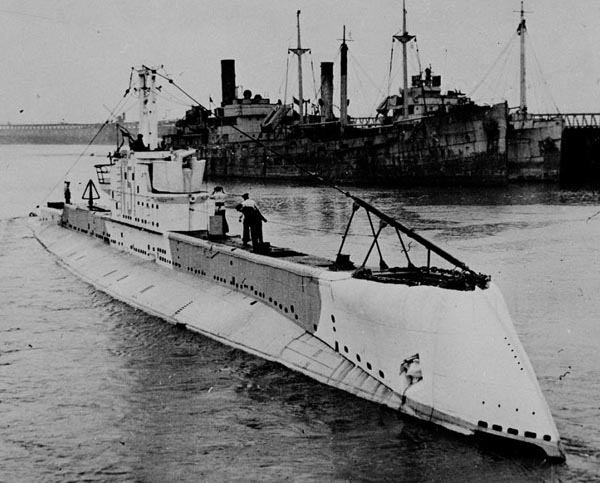
HMS Otway (1931) camouflaged during ww2
-The Oceanic types:
Basically the standard of the interwar, and still produced during WW2. The first of the new generation was HMS Oberon (O class, 1926), followed by the P, R and T classes (1932), displacing 2700 tonnes underwater, the Porpoise and Grampus class, which found a lighter inheritance with the Triton class (1937) and its wartime extension programme, and the 1945 A type. These were all gun-armed, placed in the kiosk like many Italian and French models, and capable of long range patrols along sea lanes.
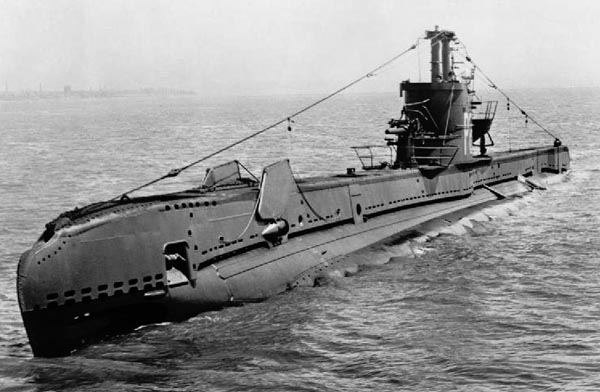
HMS Stonehenge
-The coastal types: 600 tonners comparable to the types built by the French and Italian navies in the Mediterranean. The Swordfish class is considered their common ancestor, and it became a popular type during the war. The smaller U class (1937) setup a standard for the wartime repeat U class of the 1941 and 1942 programmes. They were gun-armed, but the latter was a light deck gun, generally dual purpose. They were able to dive fast, had excellent underwater performances, and were better suited for Mediterranean waters. And despite ASW measures of the Regia Marina later during the war, their attrition rate was reduced to almost nil.
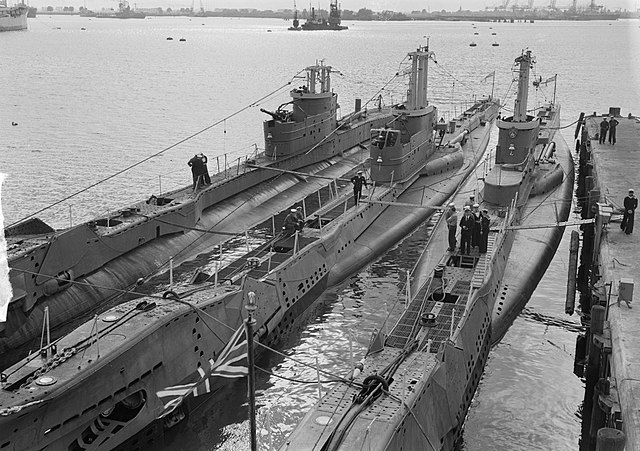
Amphion class Submarines in Rotterdam, 1949
War Prizes: U141 & UC5

Comparison between the U-139 class and a coastal UB type.
As other members of the entente, the United Kingdom obtained naval compensations from Germany: The only U-Boat obtained was U141 (Captain Otto Weddingen), and ‘Unterseeboote Kreuzer‘ of the 1917 U-139 class, studied and tested until scrapped in 1923. This was a good insight in German tech of the time for large oceanic models. The good surface range and speed notably by optimizing the powerplant and the compartimentation, pressure hull, were all not forgotten and the auxiliary diesels were reused, and arrangement solutions were passed onto the X1. On its side, UC-5, a coastal minelayer type, was also granted to the Royal Navy to be studied and scrapped in 1923.
Submersible production
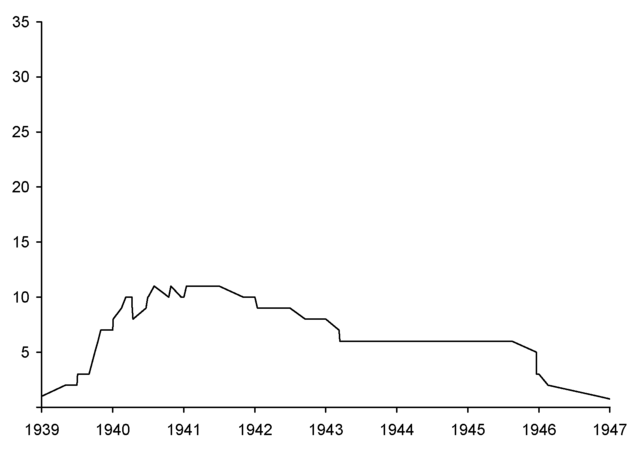
In terms of production, Great Britain restarted its submersible construction from 1919 for the experimental X1, as well as completed several models, of the L50 type notably, too advanced to be scrapped, but most of the latter class was cancelled while production has just started. Studies for the O class started in 1922, the first, HMS Oberon, laid down in 1924. So there was practically no gap in production, but it started slowly.
Launchings: Three in 1926, Five 1928, seven 1929, four 1930, one 1931, three 1932, one 1933 (massive budget cuts after the 1929 crisis), six in 1934, two 1935, four 1936, four 1937, seven 1938, six 1939, and wartime production took off from this moment, with 24 submarines planned for the first war emergency programme, 44 for 1941, 52 for 1942, 36 for 1943 and 16 for 1944, none for 1945 (The A class were from the 1944 program). This easily showed priorities shifted during the war. 1942 already shown the positive experience of submarine warfare in the Mediterranean but past the Italian Capitulation in September 1943, priority returned to surface escorts and destroyers.
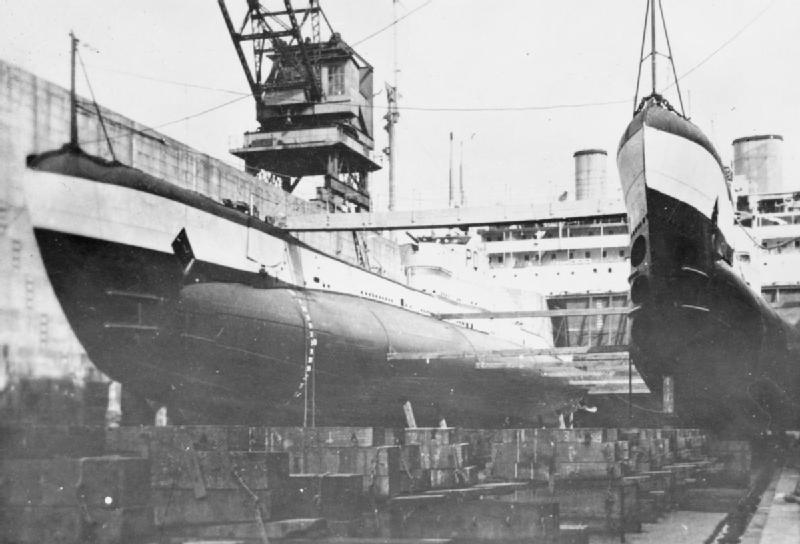
HMSM Proteus and Poseidon in completion
The yards concerned were:
-Chatham DyD (X1, Oberon, Odin, Rainbow, the Swordfish class, some Grampus, Shark class…)
-Beardmore (Two O class)
-Scotts (hms Cachalot, Seawolf, Tuna, some T class)
-Cammel Laird (Some T class)
-Devonport DyD (some T class)
-Portsmouth DyD (some T class)
-Vickers Armstrong, Barrow (Mostly wartime programme boats, small U class subs)
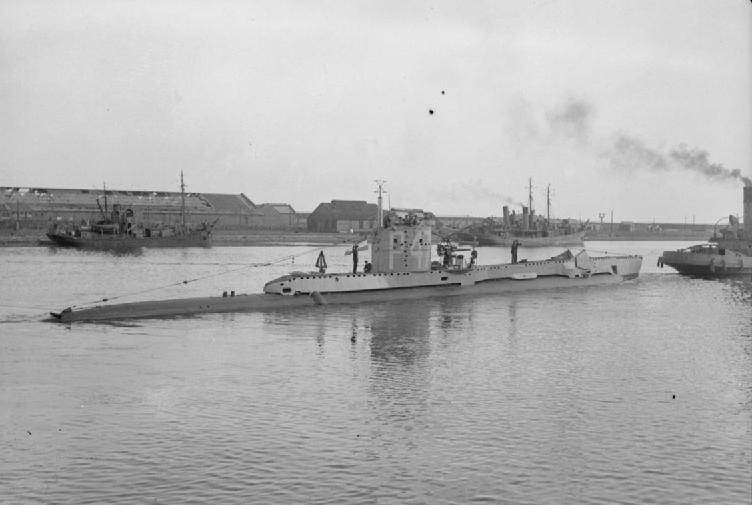
Submersible P-47, a modified U-Type from the war emergency program, built in Vickers Armstrong. She was one of the 28 unnamed subs launched in 1941 (all but eight renamed). With 46 built between 1939 and 1943, the U class was by far the largest submarine class ever built by Great Britain, even compared to the prolific L from WW1.
Production wise, it is established as follows:
-O class: 9 boats
-P/R class: 10 boats
-Thames, Grampus class: 8 boats
-S class (swordfish, Shark +1941 WEP 41): 62
-T class (Triton + WEP 40, 41, 42): 53
-U class (Undine + WEP 41, 42): 72
-A class: 16
-P611 Class (Turkish requisitions): 4
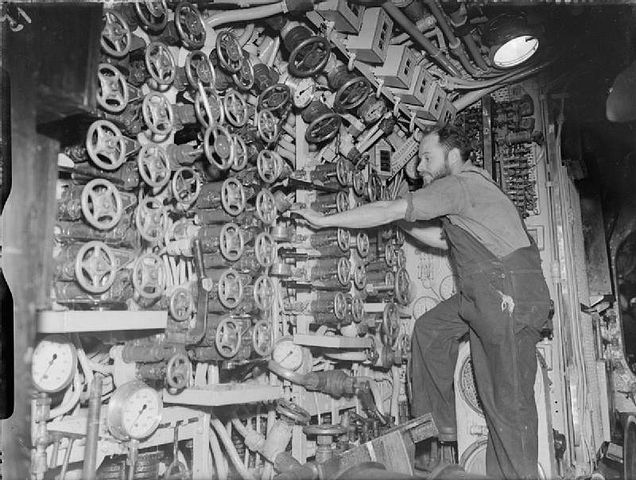
Inside HMS Osiris
Characteristics of British Subs
Unlike the American and Japanese which tailored their models for Pacific operations, therefore long range, growing the size of the submarines, the British made their own for the European theatre: The Mediterranean seemed the most appropriate, and for most of the interwar, British submarines were rather large, 80-90 m long for 2500 tonnes underwater. Their trademark was a casemated gun, place high up on a raise platform part of the kiosk.
Hull and propulsion
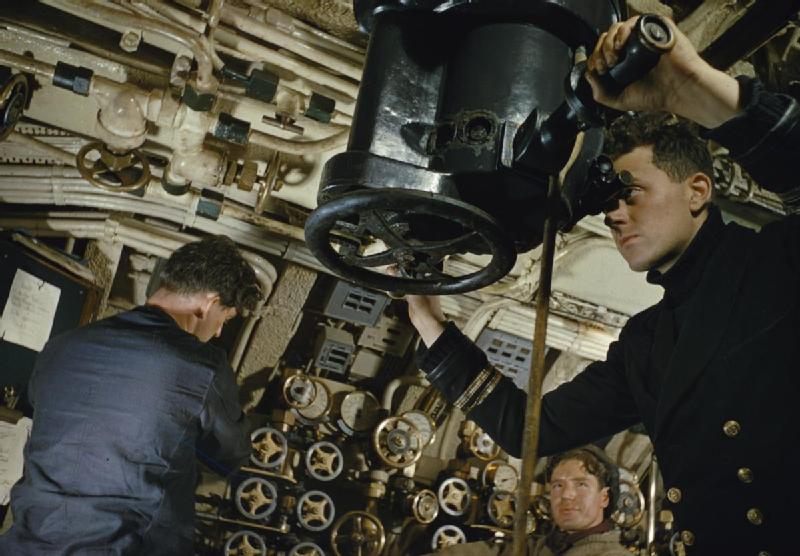
on board hms Tribune, 1942
For hulls, X1 pioneered a new kind of double hull, adopted for subsequent constructions in 1925. It was very much inspired by the U-141’s sturdy construction.
No surprises here, all boats were propelled in a conventional way with diesels and electric motors and a ratio of around 1/2 in power for surface propulsion.
The diesels were built under admiralty specifications and called that way, in alternative to Vickers for the Oxley class (1926). Electric motors were also made by Vickers.
There were exception though, like the X1 fitted with ex-German MAN auxiliary diesels which sole purpose was to reload the electric motors, in addition to larger admiralty diesels. The very large Thames class (1932) had 10,000 bhp supercharged admiralty diesels in order to reach 22.5 knots on surface and 10 submerged. They were the fastest, longer range of all cruiser submarines in service in WW2, and were used like the O class to patrol distant stations and trade lanes.
Coastal types like the Swordfish class, seen as the forerunner of the S class with the larger Shark (1934) were characterized by better underwater performances and a power ratio of 15/14 K shp, for 13 to 15/10 knots. The larger T class were faster on surface at 15.25/9 knots up to 18.5/8 knots on the late war A class.
The smaller of the bunch, the U class, were almost as fast underwater than on surface, with an inverted power ratio of 615/825 shp and Paxman Ricardo diesels.
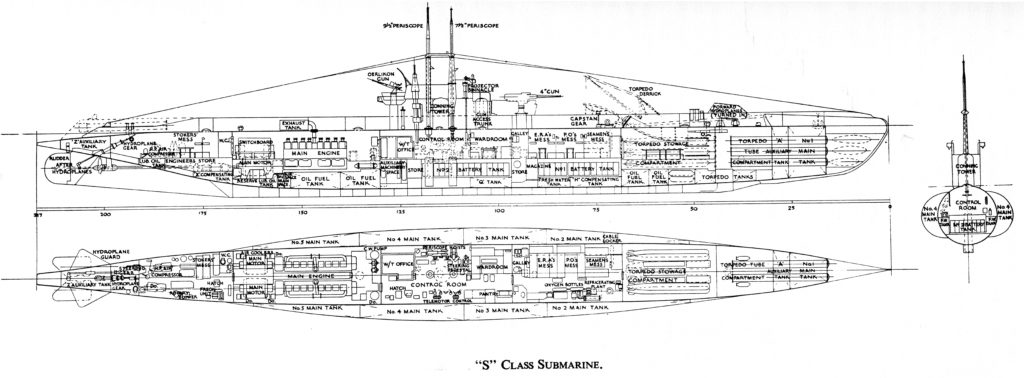
British S-class blueprint and construction details
CC Photos:
https://commons.wikimedia.org/wiki/Category:British_U_class_submarine
https://commons.wikimedia.org/wiki/Category:British_T_class_submarine
https://commons.wikimedia.org/wiki/Category:British_S_class_submarine_(1931)
https://commons.wikimedia.org/wiki/Category:Amphion_class_submarines
https://en.wikipedia.org/wiki/British_S-class_submarine_(1931)
https://en.wikipedia.org/wiki/British_T-class_submarine
Armament: Torpedoes
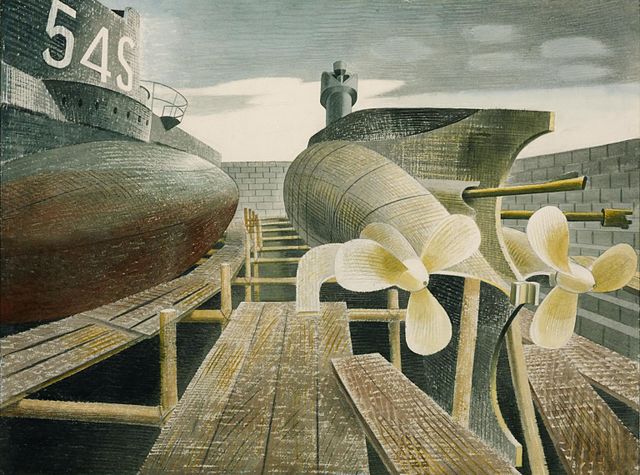
-21 inches (533 mm) Mark VIII and VIII** (1925-27):
Equipped all Submarines from the “O” Class onwards. The world’s first burner-cycle model. It weighted 3,452 lbs. (1,566 kg) for an overall Length of 21 ft 7 in (6.579 m), a negative Buoyancy of 804 lbs. (365 kg)and an explosive Charge Mark VIII weighting 750 lbs. (340 kg) TNT.
The 722 lbs. (327 kg) TNT warhead became later 805 lbs. (365 kg) Torpex model. It was 5,000 yards (4,570 m)/40 knots for the Mark VIII**and the same at 45.5 knots for the standard model, or 7,000 yards (6,400 m)/41 knots.
-21 inches (533 mm) Mark X*** and X**** (1940): The Mark X*** was used by Dutch Submarines and the Mark X**** used on Greek Submarines. Powered by a wet-heater, it weighted 3,571 lbs. (1,620 kg) for an overall Length of 23 ft 7.5 in (7.200 m) and a negative Buoyancy of 606 lbs. (275 kg), and explosive Charge of 661 lbs. (300 kg) TNT.
This model could reach 3,280 yards (3,000 m)/47 knots, 5,470 yards (5,000 m)/43 knots, 8,750 yards (8,000 m)/36 knots, or 13,120 yards (12,000 m)/29 knots.
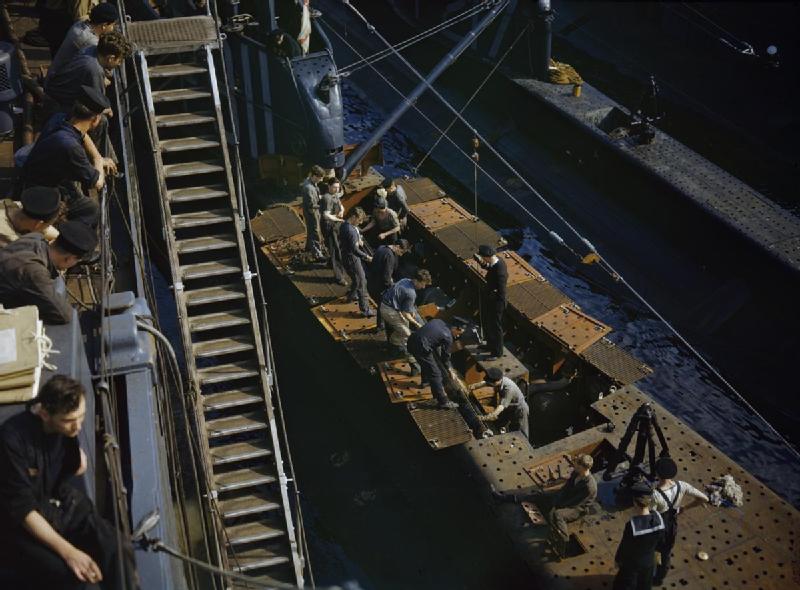
A torpedo supply seen from the submarine depot ship HMS Forth, in Holy Loch, Scotland 1942
In reserve:
-The oldest models were probably the 21 inches (53.3 cm) Marks II, II* and II**. They were introduced into service in 1914 in produced also for destroyers. They were still used by old vessels in WW2, notably the lend-lease Flush Deck destroyers and were available for submersibles in case, but probably somewhat to use. Used a Wet-heater, 515 lbs. (234 kg) TNT, 35 knots and up to 5000 m. World War II submarines models were capable of 5,000 yards (4,570 m) at 35 knots.
-21 inches (53.3 cm) Mark III, no information
-21 inches (53.3 cm) Mark IV and Mark IV*: Used by submarines. In service by 2016, same propulsion, 515 lbs. (234 kg) TNT warhead, and WW2 submarines had a double setting, 6,000 yards (5,500 m)/40 knots and 9,500 yards (8,700 m)/35 knots.
Armament: Guns and AA
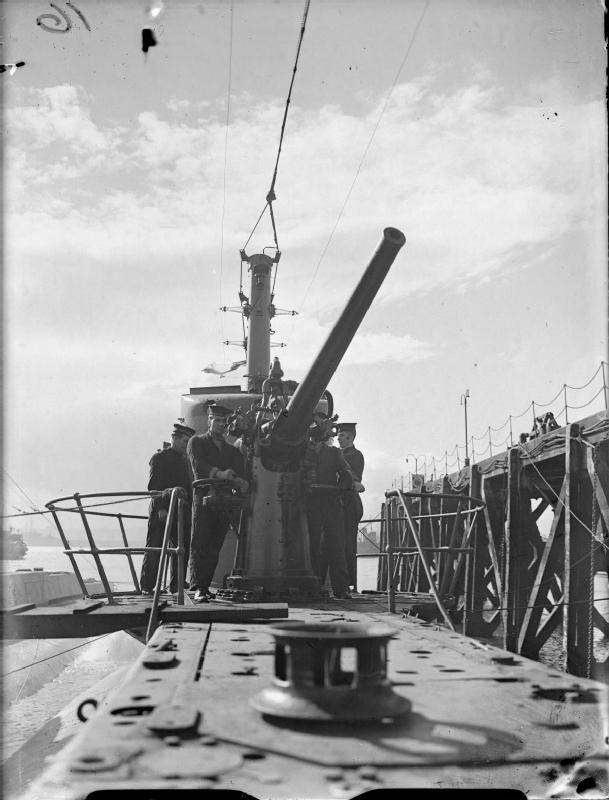
-Cruiser Submarine X1: Sole British model fitted with turrets for 5.2″/42 (13.2 cm) QF Mark I.
-“A” and “T” classes: 4-in/33 (10.2 cm) QF Mark XXIII:The war ended before they could be operational
-Most submarines until 1945: 4-in/40 (10.2 cm) QF Marks IV, XII and XXII
-Other submarines of the interwar and WW2: 4″/40 (10.2 cm) BL Mark VIII and Mark XI
-3 in/20cwt
-12 pdr/12 cwt
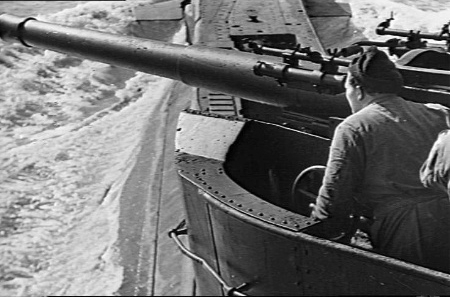
QF 4 inch Mk XII gun fired from a T class submarine (AWM)
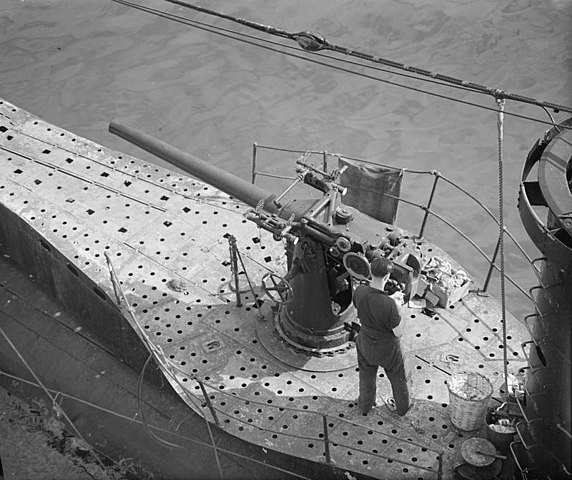
The gun deck of an U-class boat
WW1-era British submarines
 H class 1917-18
H class 1917-18
Also called Holland type 602, the H class was the most important class of submersible allies of the great war. Designed by the American pioneer John Philip Holland, it was an improvement on the previous types, simplified for the large series. Most were built in the USA by Electric Boat Co. Others were built by Vickers under license, including Class H present, supplied to the Royal Navy, and the 10 of the first group (1915) by Canadian Vickers in Montreal for the navy Canadian.
The last series built in Great Britain counted 25 units between 1917 and 1919, some of which were put into service after the war. Very solid, reliable, capable of spinning very quickly in diving, characteristic of Holland, they remained in active service until the thirties before going to schooling. 9 were still in service in 1938 and actively participated in the war in the Mediterranean. Two were sunk there, the H31 and H49. Characteristics (Class H in 1939):

Displacement
Displacement: 390 t. standard -520 t. sub
Dimensions: 46 m long, 4.9 m wide, 3.8 m draft.
Propulsion: 2 shafts diesels + electric motors 400 hp. surf./uw speed: 14.5/10.5 knots.
Armament: 4 TT 533 mm (bow), 1 x 45/47 mm (3-pdr), 1 MG, 8 torpedoes.
Crew: 32
 L class 1918-19
L class 1918-19
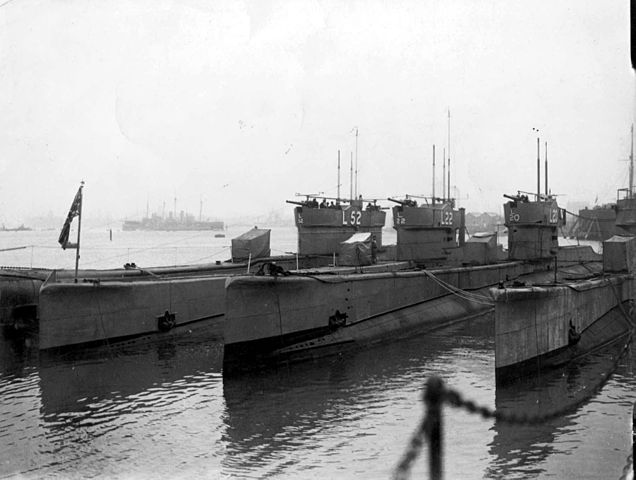
L-class boats in Gosport, 1933, L52 was one of the last, completed after WW2
Class L was one of the oldest in service in the Royal Navy in 1939. In fact, they were survivors of a prolific class of 71 units started in 1918 and completed after the war. Light ocean submersibles, they had a masked artillery piece, in a kiosk bath at the front, which became the hallmark of British submersibles in the years that followed. During the interwar period, these sturdy vessels formed the backbone of the submersible force in the Royal Navy, but by 1936 their age and technology had caught up with them. The last three were used for schooling, and were used as patrol boats in the Atlantic. They survived the Second World War.

Characteristics (1939):
Displacement: 914 t. standard -1024 t. Diving
Dimensions: 62 m long, 6.5 m wide, 5.2 m draft.
Propulsion: 2 shafts Vickers diesels 850 hp + 2 electric motors 550 hp. 13/11 knots sf./uw.
Armament: 6 TT 21-in (533 mm) (4 bow, 2 stern), 1 x 4in (104 mm), 1 MG.
Crew: 58
Interwar British submarines
Focus: The experimental cruiser X1 (1923)
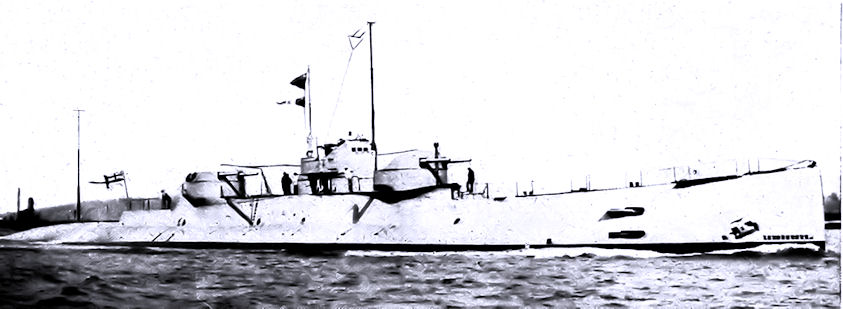
HM Submarine X1 was the idea of testing the raiding submersible cruiser pioneered by Germany during WW1. This commerce raider became when launched, the world’s largest submarine and stayed the largest British submarine before the 1960s and first nuclear-propelled models.
A top secret project:
The idea was proposed already in 1915, but work was not started before 1921. The X1 was largely based on the uncompleted German U-173 class, the last “U-cruisers” of which plans were obtained by the admiralty as a war prize. X1 was eventually laid down on 2 November 1921 at Chatham, completed on 23 September 1925 and commissioned in December. The 1922 Washington Naval Treaty ban the use of submarines against merchant shipping, so contradicted by X1, but her powerful armament was presented as tailored to engage and destroy only escorting vessels, destroyers and frigates. Secrecy surrounded the project anyway, and the government tried to prevent leaks and confiscated pictures to the point of publication in a national newspaper.
Design:
The X1’s had a thick pressure hull 19 feet 7.5 inches (6.0 m) in diameter, divided into 10 watertight compartments and 1-inch (25 mm) thick to support greater dephts than any other model in service, namely 500 feet (150 m), later reduced to 350 feet (110 m) for service. This internal hull was surrounded by a wide external hull containing the main ballast tanks and fuel reserves.
Armament-wise, X1’s trump card were he two semi-open unarmoured turrets and tailored twin QF 5.2 inch Mk I guns forward and one aft of the conning tower. These were of unusual caliber (133 mm) inferior to light cruisers (6-in/152 mm) but the same range at 16,000 yards (15,000 m) thanks to their high velocity. There was circular trunk between both turrets which housed the waterproof magazine in the pressure hull with 100 rounds per gun 400 total. The ammunition hoists were designed in such way they could not sustain the desired rate of fire (6 rpm). Special ballast tanks were also added to compensate to make for the loss of spent ammunition’s weight. The guns management was also a failure in the sense they required 58 men, basically half of the crew.
The fire-control tower was installed in the conning tower, her telescopic top section raised 2 feet (0.61 m) for operations. The upper control room was located below, just above the pressure hull. Aft of it was located the rangefinding room, suing a 9-foot (2.7 m) rangefinder also telescopic and raised 8 feet (2.4 m) when used. Like other subs, X1 had six bow tubes, standard 21-inch (530 mm) models, which were spares from the cancelled L-class boats, with one reload for each tube. Designs particulars made the torpedo room cramped to it took 24 minutes to reload.
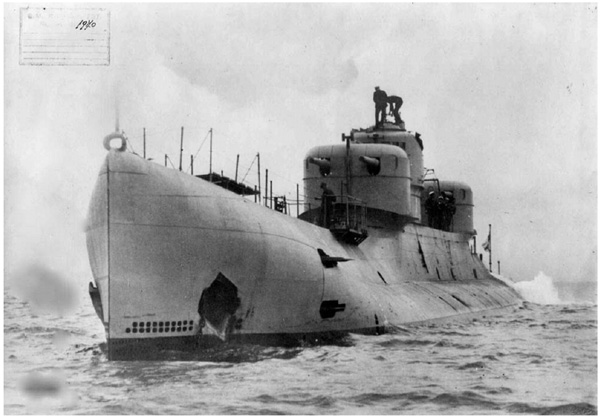
X1 prow (reddit)
Propulsion-wise, the X1 relied on two shafts, connected to two 8-cylinder Admiralty diesels, for 1,500 shp each or 3,000 total (2,200 kW), and two auxiliary 1,200-horsepower (890 kW) MAN diesels from the war prize U-126, only for battery-charging purposes. In theory engineers wanted to allow them to reload batteries underwater, venting out the exhaust gasses, but taking oxygen from the interior of the boat, however the idea was dropped. Underwater propulsion relied on two GEC electric motors, developing 1,000 horsepower (750 kW) each.
When using all in combination on surface, with the auxiliaries, it was hoped to develop 8,000 horsepower (6,000 kW) total, but March 1926 full power trials only allowed to reach 7,135 horsepower (5,321 kW). Three groups of batteries, used 110 cells each, and weighted as much as 70 long tons (71 t). Design speed was 19.5 knots (36.1 km/h; 22.4 mph) surfaced, and range was excellent at 8 knots but the diesel engines were marred with technical issues and were unreliable. The X1 was also a relatively slow diver, in 2 minutes 20 seconds but she handled well underwater, moreover for such large model.
X1 was commissioned in December 1925, accepted for service in April 1926 and sailed to Gibraltar only to have her engines repaired, only to have a breaking of her starboard camshaft driveshaft during a fast run in January 1928. She was refitting at Malta when her port camshaft driveshaft also broke in April. 1930’s commanding officer report was very critical, speaking of “internal arrangements not satisfactory because of overcrowding with auxiliary machinery, accommodation cramped, poor ventilation, humidity…”
The main and auxiliary engines were almost continuously repaired and so X1 was considered a failure and retired as soon as 1930, placed in reserve pending a replacement or redesign, until it was decided to scrap her at Pembroke on 12 December 1936. Despite of this, X1 had a tremendous influence, it was publicized by the press as the Royal Navy’s dreadful secret weapon in case of war, and influenced the Americans, Japanese and French, the latter designing the Surcouf also in the 1920s, but with an observation plane and heavy cruiser (8 in) guns.
Characteristics (1939):
Displacement: 2780 t. standard 3600 t. Diving
Dimensions: 110.8 x 9.1 x 4.6 m draft (363 x 30 x 15 ft)
Propulsion: 2 shafts, 4 Vickers diesels, 2 electric motors 4200+1000 hp. 19.5/9 knots
Endurance/Range: 12,400 nmi (23,000 km; 14,300 mi)/12 kts to 18,700 nmi/8 knots, 50 nmi/4 knots sub.
Armament: 6 TT 21-in (533 mm) (bow), 2×2 5.25 in (133 mm) guns
Crew: 90
 Oberon/Oxley class (1926)
Oberon/Oxley class (1926)
Oberon, Otway, Oxley

HMS Oberon
Since the L, no ocean submersible had been built. The admiralty studied a number of proposals for a model cruise intermediate between the enormous XI of 1921, and the “L” which were somewhat limited for their role. In the end, a Vickers design based on the enlarged and improved “L” was chosen. Three units (Oberon, Oxley, Otway) were built at Chatham and Vickers-Armstrong, the last two assigned to the RAN (Royal Australian Navy) in 1930. During the war, HMS Oxley was the only loss, torpedoed by mistake by the hms Triton.

Characteristics (Oberon class in 1939):
Displacement: 1850 t. standard -2720 t. Diving
Dimensions: 84 m long, 8.4 m wide, 4.8 m draft.
Propulsion: 2 shafts Vickers diesels, 2 electric motors 3100+1350 shp. 15/8.5 knots.
Armament: 8 TLT 533 mm (2 stern), 1 x 102 mm, 1 x 20 mm AA gun (ww2).
Crew: 55
 Odin class (1928)
Odin class (1928)
Odin, Olympus, Orpheus, Osiris, Oswald, Otus
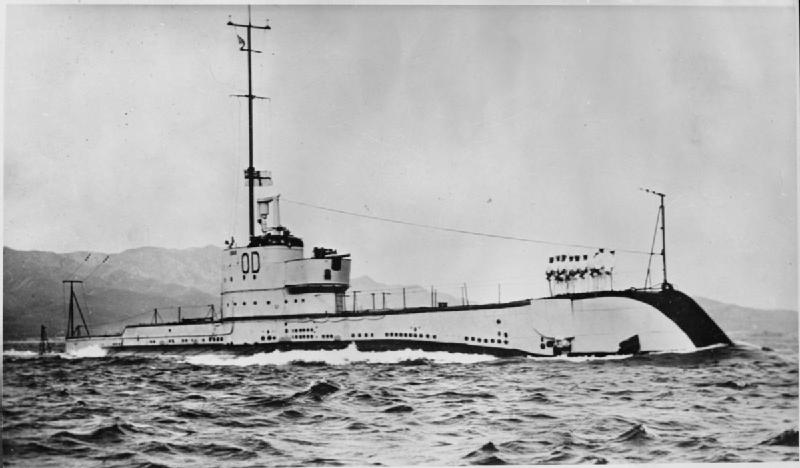
Succeeding the lead ship HMS Oberon, the Odin class were an improvement especially in terms of speed and dive time, as well as a substantial depth bonus with a crushing limit increased to 200 meters and a practical depth to 150 meters … 6 buildings were built at Vickers Barrow and William Beardmore. They are often linked to Oberon / Oxley because of their very similar characteristics. They were launched in 1928-29 and in service in 1930. Their fuel oil tanks were external and riveted, which posed problems in the event of grenadage … Four units were lost in mission in 1940 (Odin, Oswald, Orpheus) in Mediterranean following grenades from Italian destroyers and patrol boats, and HMS Olympus by a mine in 1942.

Characteristics (Oberon class in 1939)
Displacement: 1850 t. standard -2720 t. Diving
Dimensions: 86.4 m long, 9.12 m wide, 4.9 m draft.
Propulsion: 2 shafts Vickers diesels, 2 electric motors 4250+1390 shp. 17.5/8 knots.
Armament: 8 TT 533 mm (including 2 stern) 14 torpedoes, 1 x 102 mm.
Crew: 53
 Parthian class (1929)
Parthian class (1929)
Pandora, Parthian, Perseus, Phoenix, Poseidon, Proteus
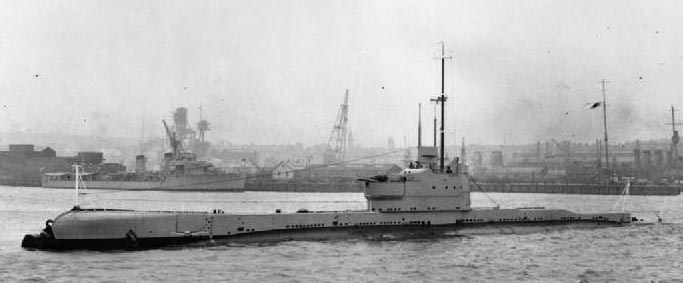
After the Oberon/Odin, the admiralty decided to keep most of the previous series, but still improving their performance. It was done thanks to an even more powerful diesel-electric couple, and a hull with reworked hydrodynamics, mainly the bow. 6 buildings were built (Parthian, Perseus, Pandora, Phoenix, Poseidon, Proteux), launched in 1929-1930 and intended to operate in the Far East. In reality, they were assigned to the Mediterranean. The poseidon, was lost following a collision with a freighter in 1931. Only the Proteux survived the war, the others were lost by acts of war, the Pandora by an Italian plane, the Parthian and Perseus by mines, the Phoenix by an Italian torpedo boat.

Characteristics (1939)
Displacement: 1850 t. standard -2720 t. Diving
Dimensions: 86.4 m long, 9.12 m wide, 4.9 m draft.
Propulsion: 2 shafts Vickers diesels, 2 electric motors 4640+1635 shp. 17.5/8.6 knots.
Armament: 8 TT 533 mm (including 2 stern) and 14 torpedoes, 1 piece of 102 mm.
Crew: 53
 Grampus class (1932)
Grampus class (1932)
HMS Porpoise, Grampus, Narwhal, Rorqual, Cachalot, Seal
The need to design mine-laying submersibles, in the context of a possible blockade of German trade routes, and in particular the Skattegat area, the admiralty sent in 1930 a specification for long-autonomy mine-laying submersibles. The first built was HMS Porpoise, launched in 1932, and which had two longitudinal galleries endowed with mines like the pioneer that was the M3 of 1918. It was followed by a series of 5 other units in 1936-38, distinguished under the name of “Grampus class”. These units were based in the Mediterranean, notably distinguishing themselves by supplying Malta, during the “Magic Carpet” operation. Only one survivor of the war, the hms Rorqual, 4 others were sunk in operations including one (the hms Porpoise) in the Far East and another, the hms Seal, captured in 1940 in the Skattegat, disabled by one of its own mines , by the Germans who put it back into service under the name of UB, and scuttled after having seen some operations in the Baltic, in May 1945.

Characteristics (Porpoise and Grampus class)
Displacement: 1768-1810 t. standard -2035-2157 t. Diving
Dimensions: 88-89 m long, 6.80 m wide, 5.12 m draft.
Propulsion: 2 propellers, 2 diesel-electric, 3300/1630 hp. Maximum surface / dive speed: 15.5 / 8.7 knots.
Armament: 6 TLT 533 mm (bow), 1 piece of 102 mm MK XII, 12 torpedoes and 50 mines.
Crew: 59
 Thames class (1932)
Thames class (1932)
HMS Thames, Severn, Mersey
These three units (Thames, Severn and Mersey), were built as submersible wing cruisers, designed to accompany the fleet but also for long patrols of the Indian Ocean and the Pacific. They were the largest since the XI of 1923. They were also called “class River”. The power of their propulsive device also explains their vast dimensions: They were designed on paper to reach 20 knots on the surface, at the time sufficient to follow battleships at full speed. The design was ready at Vickers Barrow, near Furness, in 1928, and the admiralty approved it the following year. Construction quickly followed and the three units were launched in 1932-34.
Expensive, these compromise vessels only dived at 90 meters (safety), compared to the 150 meters of the previous ones, the hull had been notably lightened and refined. Their Diesels were fitted with Ricardo breeders giving them a power boost (up to 10,000 hp). During the war, the Thames participated in operations in Norway and was sunk there on September 23, 1940. The other two served in the Mediterranean and were transferred in 1943 to the Far East. They survived the war but were quickly removed from service.

Characteristics (Thames class)
Displacement: 2206 t. standard -2720 t. Diving
Dimensions: 105.15 m long, 8.80 m wide, 4.85 m draft.
Propulsion: 2 propellers, 2 diesel-electrics, 10,000 / 2,500 hp. Maximum surface / dive speed: 22/10 knots.
Armament: 6 TLT 533 mm (bow), 1 piece of 102 mm MK XII, 12 torpedoes.
Crew: 61
WW2 British submarines
 T class (1937)
T class (1937)
HMS Triton, Thetis, Tribune, Trident, Triumph, Taku, Tarpon, Thistle, Tigris, Triad, Truant, Tuna, Talisman, Tetrarch, Torbay (gpe II) Tempest, Thorn, Thrasher, Traveller, Trooper, Trusty, Turbulent (Gpe III) P311, Trespasser, Taurus, Tactician, Truculent, Templar, Tally-Ho, Tantalus, Tantivy (FY1941) Telemachus, Talent, Terrapin, Thorough, Thule, Tudor, Tireless, Token, Tradewind, Trenchant, Tiptoe, Trump, Taciturn, Tapir, Tarn, Talent, Teredo (FY1942) Tabard, Totem, Truncheon, Turpin, Thermopylae (FY1943), Thor, Tiara, Theban, Talent, Threat, P345, P346, P347, P348 (Never completed).
The modernization of the types of ocean submersibles used in the 20s and 30s, improved in detail since the Thames, and supposed to replace the O, P and R, leads to the T series or Triton, named after the first in 1938. They were large ocean-going vessels capable of complete autonomy for the Atlantic. The first 15 units were built just before the war, followed by two groups during the conflict, bringing the total to some 53 units, the last operational in 1946-47. Their career will be long, the last in service was not withdrawn until 1977.
The first design, called “repeat P” was started in 1934. Their genesis was all the longer since they had to meet demanding specifications. Among the requirements were the possibility of launching no less than 10 torpedoes from the front. This figure was later lowered. Their autonomy was 8,000 nautical miles, but was increased to 11,000 nautical miles at 10 knots on the surface, improved on the second and third group.
During the war, most were posted in the Mediterranean, and they suffered a total of more than 25% of losses. After the war, only the surviving units of the third group (1943-46) were taken over for recasting. We added a powerful sonar at the front in a bow bulb, their hull was “streamlined” and their engine modernized, as well as the periscope, communication and electronic equipment on board. Thus modernized, they served until the 1960s … Characteristics (Class T, second group, 1940):


Specifications
Displacement: 1290 t. standard -1560 t. Diving
Dimensions: 84.28 m long, 7.77 m wide, 4.45 m draft.
Propulsion: 2 propellers, 2 diesel-electrics, 2500/1450 hp. Maximum surface / dive speed: 15.5 / 8 knots.
Armament: 6 TLT 533 mm (bow), 4 TLT 533 mm (stern), 1 piece of 100 mm MK XII, 16 torpedoes.
Crew: 48
 S class (1937)
S class (1937)
(FY1929) HMS Swordfish, Sturgeon, Seahorse, Starfish (FY1930-35) HMS Sealion, Shark, Snapper, Salmon, Seawolf, Spearfish, Sunfish, HMS Sterlet (FY1939) HMS Safari, Sahib, Saracen, Satyr, Sceptre (FY1940) HMS Seadog, Sibyl, Sea Rover, Seraph, Shakespeare, P222, Sea Nymph, Sickle, Simoom, Sirdar, Spiteful, Splendid, Sportsman, (P81-87) (FY1941) HMS Stoic, Stonehenge, Storm, Stratagem, Strongbow, Spark, Scythian, Stubborn, Surf, Syrtis, Shalimar, Scotsman, Sea Devil, Spirit, Statesman (FY1942) HMS Sturdy, Stygian, Subtle, Supreme, Sea Scout, Selene, Seneschal, Sentinel, Sidon, Sleuth, Solent, Spearhead, Springer (FY1943) HMS Saga, Scorcher, Spur, Sanguine, Sea Robin, Sprightly, Surface, Surge (last 4 cancelled)

The “S” class was the most prolific dubmersible class of the war, British side. It began in 1931 on the admiralty project to replace aging H-class units for theaters of operation in the North Sea and the Mediterranean. Operating not far from the bases and therefore with limited autonomy. But against all expectations, the series did not stop in 1937, but continued, with the introduction of an “improved S” variant in 1941. In the end, this series counted 62 units, staggered until the end of the conflict. No less than 10 units were also transferred to Allied countries, including 1 to Holland, 3 to Portugal, 4 to Free France, and 2 to Israel after the war.
The production was spread out in three successive groups: The first group of 1931 counted four units (Swordfish, Sturgeon, Seahorse, Starfish), the second counting 8 units spread out between 1934 and 1937 were larger by two meters, and heavier by thirty tonnes, with greater autonomy. Finally the third group was an emergency series in 1939, based on an existing and economical design, and comprised 50 units. 5 others were canceled in 1945. Dimensions and tonnages were greater (see characteristics).
Their activity was mainly confined to the Mediterranean, where they charged the heavy price for the convoys of the axis, the Regia Marina being particularly targeted. Others became famous for their actions of historic significance, such as the Seraph with the transport of General Giraud in North Africa, for example. Others disembarked and embarked members of the resistance on the ribs of the Channel. A heavy price was paid by these buildings. Of the first group of 12 buildings in service in 1939, there were only three survivors…

hms spiteful

hms safari

hms sahib
Characteristics (Class S, 3rd group, in 1939)
Displacement: 814 t. standard -842 t. Diving
Dimensions: 66 m long, 7.16 m wide, 3.4 m draft.
Propulsion: 2 shafts Vickers diesels, 2 electric motors. 14.75/8 knots.
Armament: 7 x 533 mm TTs (1 stern) 13 torpedoes, 1 x 3-in (76 mm, added during the war), 1x 20 mm AA cannon, 3 MGs
Crew: 39
 U class (1937)
U class (1937)
4 groupes, 49 submersibles
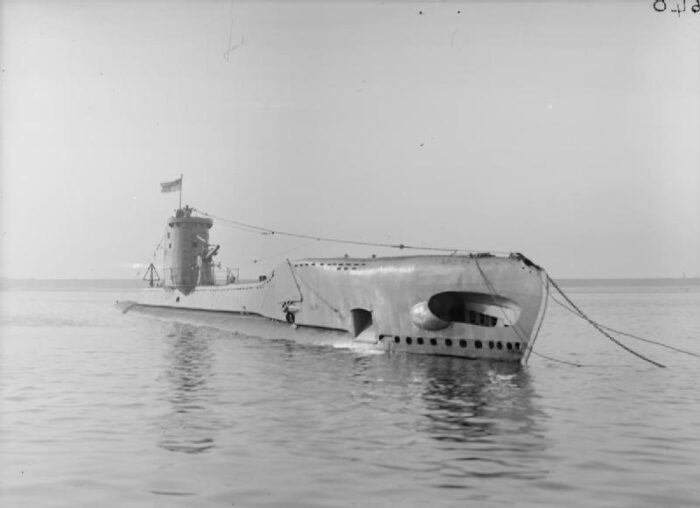
HMS Ursula (N50), first preswar Unity class.
The U-class submarines, also known as Undine-class (first of the Unity class), were a group of diesel-electric submarines built for the Royal Navy during the 1930s which saw extensive service throughout World War II. They were designe dto teplaced the WWI H class used as training subs in peacetime, and their replacemets were intended to acts as home waters patrols submarines. They were relatively small and designed for operations in the North Sea and Mediterranean, where their compact size allowed them to maneuver more easily in shallower waters. They were known for their reliability and versatility and excelled in anti-submarine warfare, reconnaissance and spec ops missions.
The class went through several iterations, each group improving upon the design of the previous one.
The U-class submarines saw extensive combat service during WWII, particularly in the Mediterranean and North Atlantic, where they conducted a variety of missions and were particularly effective in the Mediterranean, where their smaller size and shallow draft allowed them to operate close to enemy-held shores and in narrow straits, such as the Strait of Gibraltar. They helped contain the threat of Axis supply lines and contributed to the overall success of Allied naval operations.
A total of 49 U-class submarines were completed, 20 lost in action. Despite their limitations, they were a success due to their adaptability and combat effectiveness with many transferred to other navies, Royal Netherlands Navy, Polish Navy and Free French Naval Forces.
Specifications:
Displacement: Approximately 545 tons surfaced, 740 tons submerged
Length: About 58 meters (190 feet)
Propulsion: Diesel-electric system, with two diesel engines driving electric motors
Speed: 11.25 knots surfaced, 9 knots submerged
Range: About 4,500 nautical miles at 10 knots surfaced
Depth: Operational depth around 60–90 meters, with some later boats capable of deeper dives
Armament: Torpedoes: 6x 21-inch torpedo tubes in the bow, 8-10 torpedoe, 3-inch deck gun
 V class (1943)
V class (1943)
2 groups, 42 subs (22 completed)
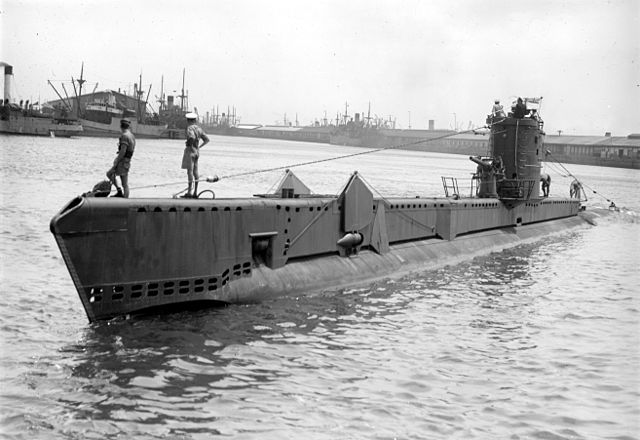
The V-class submarines, also known as the Vengeance-class, were a group of diesel-electric submarines built by the Royal Navy during World War II. Developed in the early 1940s, the V-class was intended to improve upon the earlier U-class submarines, with design adjustments for enhanced range, speed, and overall operational flexibility. These submarines were built with the specific purpose of patrolling the open ocean and supporting Allied operations in various theaters, including the North Atlantic and the Mediterranean.
They remained a relatively compact class, balancing size and power for operations in different environments with a similar layout but refined for greater endurance and torpedo capacity.
The V-class submarines were effective in their role, sinking or damaging a number of Axis vessels during the war. Despite operating under challenging conditions and facing advanced German anti-submarine technology, they achieved considerable success in disrupting enemy supply lines and providing critical support to larger naval operations, being regarded as a solid, reliable class that filled a crucial role during the later years of World War II. Postwar they contributed to the development designs and tactics, further developed into the Porpoise and Oberon.
Specifications:
Displacement: 545 tons surfaced, 740 tons submerged
Length: 62 meters (203 feet)
Propulsion: Diesel-electric, typically with two diesel engines and two electric motors for underwater propulsion
Speed: 11.5 knots surfaced, 9 knots submerged
Range: Approximately 4,500 nautical miles at 10 knots on the surface
Operational Depth: Estimated around 90 meters, with a test depth of 60-90 meters depending on specific boat modifications
Armament: Six 21-inch torpedo tubes (4 bow, 2 stern), 10 torpedoes, 3-inch deck.
 A class (1944)
A class (1944)
HMS Amphion, Astute, Auriga, Aurochs, Alcide, Alderney, Alliance, Ambush, Anchorite, Andrew, Affray, Aeneas, Alaric, Artemis, Artful, Acheron, Ace & Achates (not completed) + 29 cancelled

Called “Amphion class” or sometimes “Class A”, these units ordered by the admiralty on plans in 1943, marked a clear improvement of the many S and T of the war series, by targeting the theater of operation of the Pacific. As a result, we aimed for autonomy, speed, depth and habitability, which led to a much larger hull, with almost twice the power, and an even more robust hull. They were also the first to benefit from air conditioning.
Finally, we had envisaged their construction in series facilitated thanks to an assembly in prefabricated section, which was done for the XXI German types: Thus 8 months were necessary against 15 for the traditional T. However, the duration of their development and construction infrastructure meant that it was not until mid-1944 that the first keels were laid. In fact, out of 18 buildings launched, only two saw active service – a short time – the Amphion and the Astute, 14 others completed after the war and two used for crash diving tests.
After the war, they were renamed “Overseas Patrol Submarines”, and re-equipped with a Schnorchel, a radar, and an infrared periscope. They were reconfigured de facto to intercept Soviet submersibles and they were based in Orkney. They were partially rebuilt and modernized a second time, and saw active service before their withdrawal between 1960 and 1974.
Characteristics (Class A 1945)
Displacement: 1385 t. standard -1620 t. Diving
Dimensions: 85.80 m long, 6.80 m wide, 5.12 m draft.
Propulsion: 2 propellers, 2 diesel-electric, 6500/2000 hp. Maximum surface / dive speed: 18.5 / 5 knots, RA 10,500 nautical miles at 12 knots.
Armament: 10 TLT 533 mm (6 bow, 4 stern), 1 piece of 102 mm MK VI, 1 Orelikon of 20 mm AA, 16 torpedoes / 26 mines.
Crew: 64

hms Amphion
British submarines in Operations (1939-45)
At the start of the war, submarine crews represented a total of 168 officers, 1250 ratings, and a force of 57 to 62 submarines depending of the sources. Submarine wartime service is certainly less well known than surface branches, but submarines were awarded five of the 14 Victoria Crosses to the navy. Their motto was (and still is) “We Come Unseen”.
The nature of British submarine warfare at the early stage was very specific as Germany did not depend on heavy mercantile traffic or overseas trade. and thus there were no unprotected convoys or mercantile traffic for the British submarines to ravage. Most German mercantile traffic was confined to the North Sea, which was heavily mined. Thus, British submarines were obliged to undertake long, often fruitless patrols in these confined, dangerous waters.
The Mediterranean Campaign
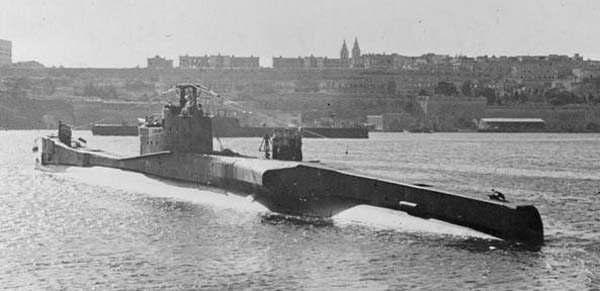
A T class submarine in Malta, 1943
The Mediterranean was the best chance to get rapid advancement: The Siege of Malta for example saw British U-class submarines in particular deployed to prey on Regia Marina’s trade roads by January 1941, increasing until late 1943. Large submarines based in the Mediterranean from 1940 accused soon 50% losses and were withdrawn. The clear and shallow waters of the are favored smaller models.
The O-class were the first in operation in the Mediterranean, and paid a heavy price, half lost (one in a “friendly fire”, three sunk in operations by Italian DDs or mine), even more for the P class (all but one sunk), three of the four Rainbow class, seven of eight Shark class, but the attrition rate diminished as mass-construction allowed more favourable statistics. Apart from a collision all late T class survived, nine war emergency programme S class (on 33), and 18 of the U-class.
U-class were even smaller than the S-class, and they started operations from the Manoel Island Base (HMS Talbot), established already in the late 1930s. This became the tenth Submarine Flotilla, under overall command of Admiral Max Horton, appointing Commander George Simpson in command, as an organic part of the First Submarine Flotilla based in Alexandria (Andrew Cunningham). Simpson had total free hand and until U-class were available; it had to make due with much the larger T-class. The latter started operations by 20 September 1940, but had a large attrition rate and had to cope also with a shortage of torpedoes.
It was so acute they operated with their guns on surface, unless it was warship, tanker or “significant vessel”. HMS Truant by herself sank half of the 37,000 long tons (38,000 t) of Italian shipping claimed. The Truant even sank another Italian submarine and a Motor Torpedo Boat (MTB). Most of the nine submarines lost were due to mines. By 14 January 1941 the unit was awarded brand new U-class submarines and successes accumulated.
HMS Upholder (Lieutenant-Commander Malcolm Wanklyn) became a newsreel celebrity, received the Victoria Cross after the rampage on an axis convoy on 25 May 1941, and sinking an Italian liner Conte Rosso. Upholder was sunk in April 1942, but performed 24 patrols, sinking around 119,000 tons; comprising three U-boats and one or two destroyers, and badly damaging a cruiser. From 8 September 1944, the Tenth Flotilla was disbanded and assets transferred to the First Submarine Flotilla at Malta. By that time, valuable targets were rare.
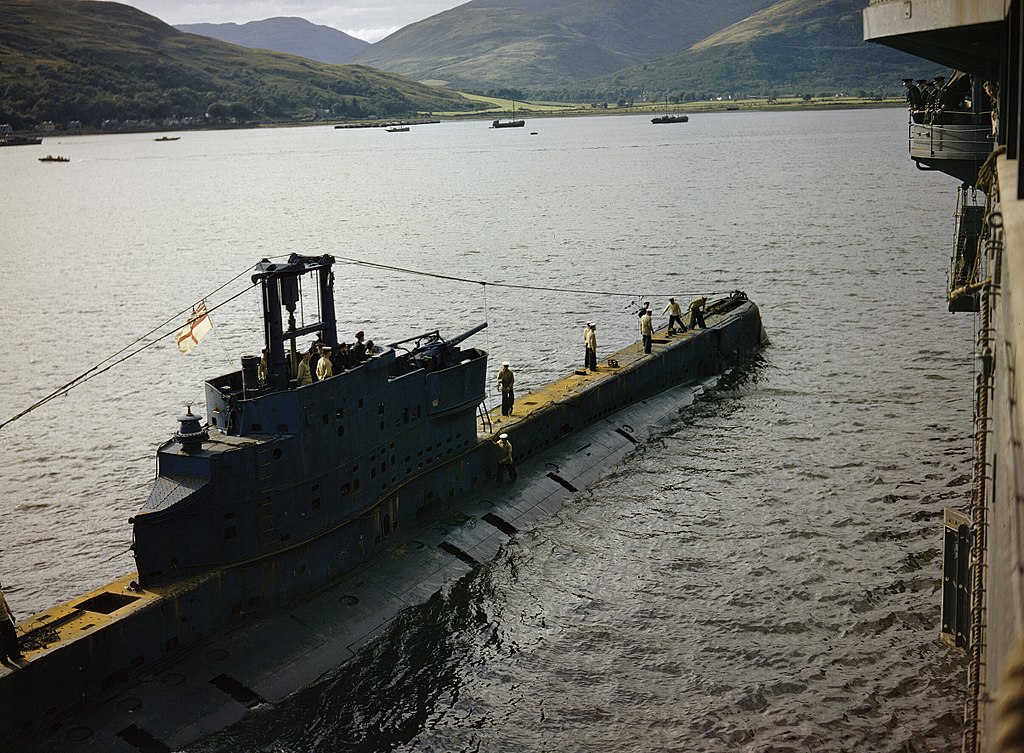
A British sub seen from the deck of depot ship HMS Forth in the holy loch, Scotland, 1942
The Atlantic/North sea Campaign
By extension this also comprised the Norwegian campaign in 1940. A large part was performed by the modern T-class submarines, heavily engaged from the North Sea to the Mediterranean and the Far East in 1944-45. On 10 September 1939, things started badly as HMS Triton (the first T class) sighted another submarine when on patrol off the coast of Norway and whe she failed to respond fired two torpedoes and sank… the HMS Oxley, also the first British submarine lost during WW2. A mine claimed HMS Triumph on 26 December 1939. The Norwegian Campaign in April 1940 saw increased Kriegsmarine traffic supporting the German invasion and in April 1940, Triton near-missed Blücher and Lützow, rampaged a German convoy and claimed the cruiser Karlsruhe. Thistle and Tarpon were also lost during that time.
The strategic Bay of Biscay, the ‘Iron Ring’ from July 1940 and after the occupation of the French Atlantic ports became more important for heavy German warships. After their raid, the Scharnhorst, Gneisenau, and Prinz Eugen were based there until their channel dash in 1941. In May 1941, the Bismarck tried to reach St Nazaire and would have been intercepted British submarines in faction as well. Long range Italian submarines started to be based in Bordeaux and by 15 December 1940 HMS Thunderbolt sunk the Tarantini, the first of 14 Axis submarines along these Iron Ring patrols. The ‘Channel Dash’ of February 1942 put an end to valuable targets there as the Kriegsmarine shifted to Norway. Submarines were also used to be posted on known routes for surface raiders to the Atlantic, and later of U-Boats.
British submarines in the Pacific
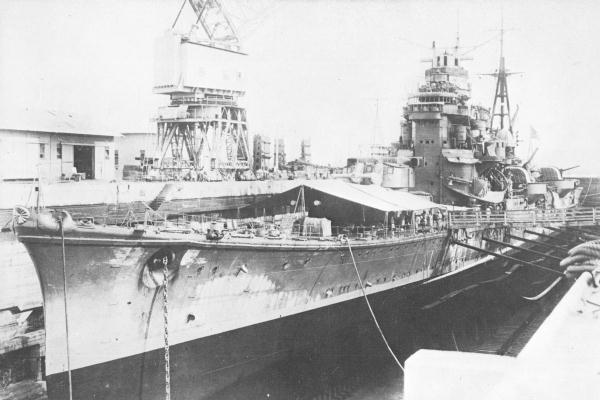
A target of choice: IJN Ashigara in Singapore, 1942
The submarine force no longer had the priority in 1944 as the Mediterranean theatre was secured and mastered by the allies so submersibles were sent to the far east, to prey on the IJN. Mostly concerned with the T-class which had the right range and capabilities for this theatre. In fact the while T the class has been designed with operations against the Japanese in mind. But none was present there in late 1941. HMS Truant and Trusty were ordered there in haste but arrived at the time Singapore fell and fled to Ceylon, operating with Dutch submarines until the end of the war. They preyed on expected Japanese route for the Indian Ocean, Truant sank two IJA transports but they never met the Kido Butai.
By late 1943 the new S and latest wartime T-class gradually arrived. The late T had modifications set for the warmer tropical climates and better suited for operations. HMS Tally Ho sank the IJN Kuma and UIT-23, HMS Taurus the I-34, HMS Telemachus the I-166, HMS Trenchant the U-859 in the Indian ocean, and the IJN Ashigara, perhaps the best success of the class. HMS Tantalous spotted the Ise and Hyūga during Operation Kita, but was too far away to catch them. Better suited for operations there, the T class, as well as the following A class had a long career postwar, modernized and streamlined, whereas the S and U classes were disarmed and scrapped soon after the end of WW2.
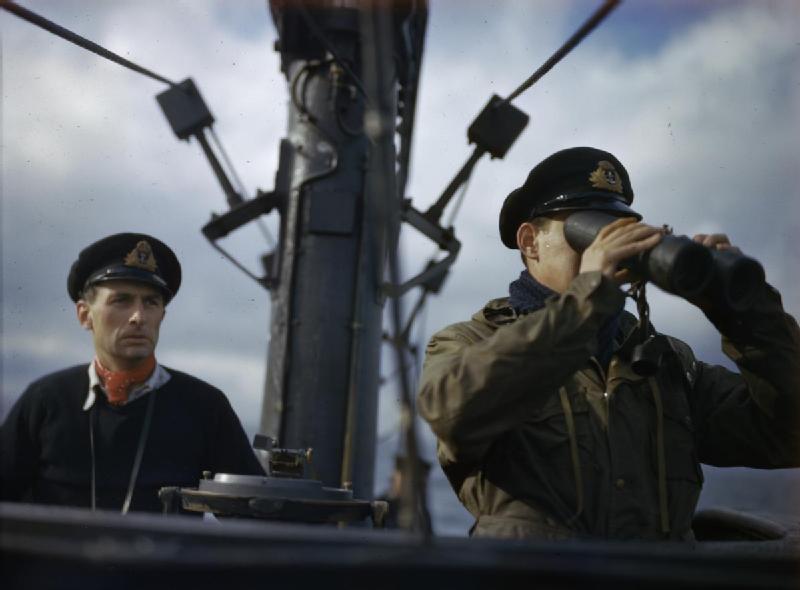
On Board HMS Tribune, 1942
About the Jolly Rogers (and other traditions):
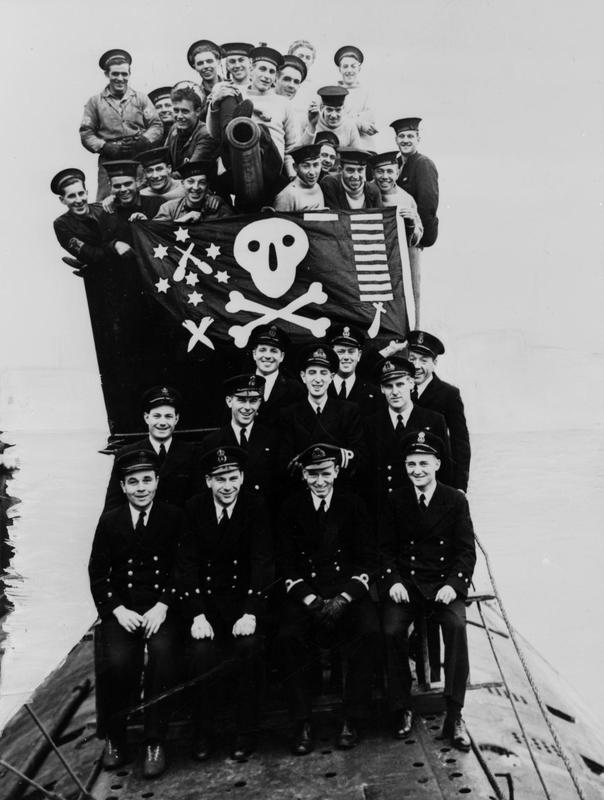
HMS Proteus returning from a mission, proudly displaying the Jolly Rogers and its hunting board, Plymouth 30 October 1942
Rear-Admiral Arthur Wilson VC, by the time Controller of the Royal Navy in 1901, claimed that submarines were “underhand, unfair, and damned un-English” and all submarines should be as pirates in wartime, hanging all crews. Despite of this he advocated the purchase of submarines in 1900 but also expressed the desire to try discouraging foreign powers from building or acquiring submarine and develop a domestic model in secret. 13 years afterwards, Lt.-Com. (later Sir) Max Horton flew the Jolly Roger while returning to port after sinking the SMS Hela and destroyer S-116 in mission, on his E-9. The joke began to stick so much that during WW2, it became customary for submarines of the Royal Navy to fly the Jolly Roger after completing a successful mission.
This went up to 1982 while returning from the Falklands after the torpedoing of the Belgrano off South Georgia, and it is now the emblem of the Royal Navy Submarine Service. Submarine crews also maintained some surface ship traditions and slang, referring to the torpedo storage compartment for example as the Bomb Shop, the diesel engine room as the Donk Shop and the the Dolphin communication Code for the entitlement of a sailor upon entering the service, awarded after qualification in a first submarine posting.
Other specificities of the British submarine’s life included the ‘Perisher’, or Submarine Command Course, held on 24-week for all officers before making it to executive officer, run twice a year since 1917, generally on 2 July and 14 November. It is still regarded as one of the toughest command courses in the world, with a 25% failure.
If that was the case, he would be nominated for boat transfer, his bag is packed for him and presented with a bottle of whisky on departure, free to serve… on the surface fleet, but keeping his dolphin as a proof of his attempt.
Src/read more
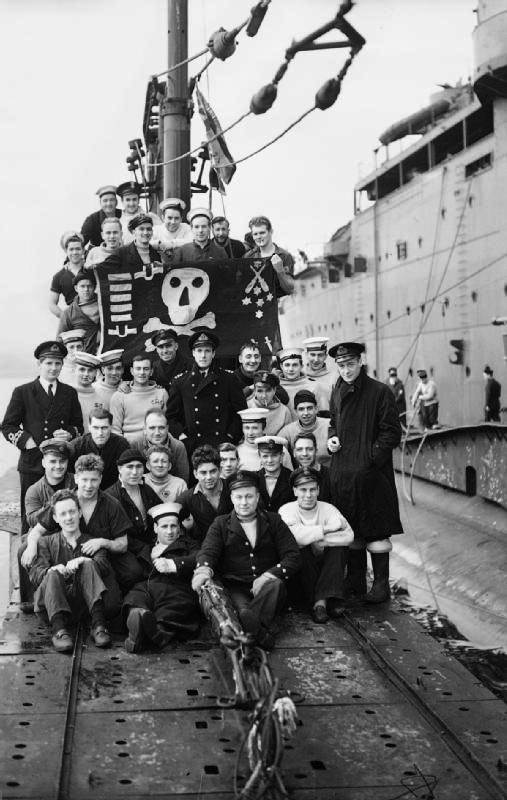
HMS Thetis crew and the Jolly Rogers
Osprey New Vanguard WW2 British Submarines
navweaps.com
wikipedia.org/wiki/British_U-class_submarine
British_T-class_submarine
www.nmrn.org.uk sub losses
uboat.net/allies/ships/rn_subs
militaryfactory.com/ships/ww2-british-submarines
warfarehistorynetwork.com pacific subs
harwichanddovercourt.co.uk
WW2CampaignsBritishSubs2
WW2CampaignsBritishSubs
battleships-cruisers.co.uk
uboat.net/
britsub.x10.mx/
rnsubs.co.uk/
schoolshistory.org.uk british-ww2-submarine-fleet-so-hidden
British Pathe, Sub success in the Mediterranean
Sublmarine Patrol, 1943
Books:
Akermann, Paul (2002). Encyclopaedia of British Submarines 1901–1955 (reprint of the 1989 ed.). Penzance, Cornwall: Periscope Publishing.
Bagnasco, Erminio (1977). Submarines of World War Two. Annapolis, Maryland: Naval Institute Press. ISBN 0-87021-962-6.
Colledge, J. J.; Warlow, Ben (2006) [1969]. Ships of the Royal Navy: The Complete Record of all Fighting Ships of the Royal Navy
Chesneau, Roger, ed. (1980). Conway’s All the World’s Fighting Ships 1922–1946. Greenwich, UK: Conway.
McCartney, Innes (2006). British Submarines 1939–1945. New Vanguard. 129. Oxford, UK: Osprey.
Akermann, Paul (2002). Encyclopaedia of British Submarines 1901–1955 (reprint of the 1989 ed.). Penzance, Cornwall: Periscope Publishing.
Bagnasco, Erminio (1977). Submarines of World War Two. Annapolis, Maryland: Naval Institute Press.
Caruana, Joseph (2012). “Emergency Victualling of Malta During WWII”. Warship International. LXIX (4)
Colledge, J. J.; Warlow, Ben (2006) [1969]. Ships of the Royal Navy: The Complete Record of all Fighting Ships of the Royal Navy
Chesneau, Roger, ed. (1980). Conway’s All the World’s Fighting Ships 1922–1946. Greenwich, UK: Conway Maritime Press.
McCartney, Innes (2006). British Submarines 1939–1945. New Vanguard. 129. Oxford, UK: Osprey.
“Parthian class submarine”. Battleships-cruisers.co.uk.
“Parthian class”. BritSub.
“HMS Pandora”. Uboat.net. Archived from the original on 19 June 2010.
“Submarine losses 1904 to present day”. Royal Navy Submarine Museum.
The model’s corner:
-MikroMir 350-025 British M – Class Military Submarine 1/350 Scale Model Kit
-Mikro Mir 350-032 K-15 Class British Submarine 1/350 Scale
-1/350 British K-class submarine – NEW Mikromir model, with PE!
-Mikro Mir 35-022 British submarine Welman (W10) Scale Plastic Model Kit 1/35
-SD Model Maker: T Class Submarine Models
-1/400 01 Maobplast HMS Ursula British WWII Submarine
-HMS UNDINE (W/PHOTO ETCHED METAL PARTS) WWII ROYAL NAVY SUBMARINE 1/400 MIRAGE
-MIRAGE HOBBY 4040428 – Polish submarine ORP Sokol with photoetch
-HMS X1 midget submarine 1/35 Merit
–HMS Oberon (modernized) OKB Grigorov 1/700
-Pit-Road Odin class 1/350
More models



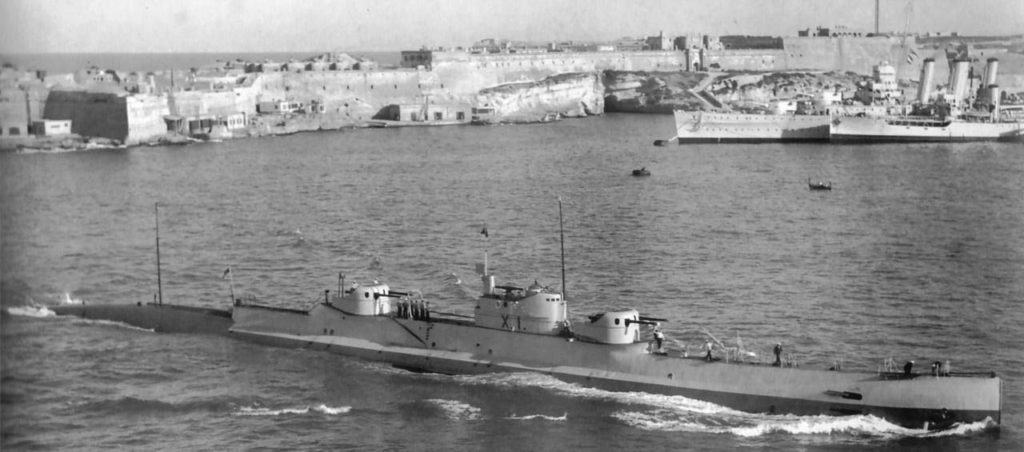

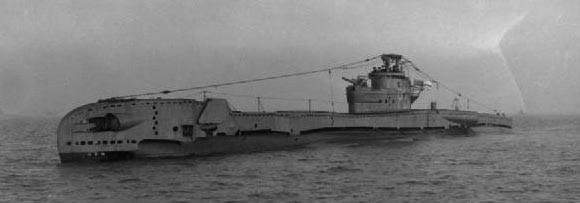
 Latest Facebook Entry -
Latest Facebook Entry -  X(Tweeter) Naval Encyclopedia's deck archive
X(Tweeter) Naval Encyclopedia's deck archive Instagram (@navalencyc)
Instagram (@navalencyc)





 French Navy
French Navy Royal Navy
Royal Navy Russian Navy
Russian Navy Armada Espanola
Armada Espanola Austrian Navy
Austrian Navy K.u.K. Kriegsmarine
K.u.K. Kriegsmarine Dansk Marine
Dansk Marine Nautiko Hellenon
Nautiko Hellenon Koninklije Marine 1870
Koninklije Marine 1870 Marinha do Brasil
Marinha do Brasil Osmanlı Donanması
Osmanlı Donanması Marina Do Peru
Marina Do Peru Marinha do Portugal
Marinha do Portugal Regia Marina 1870
Regia Marina 1870 Nihhon Kaigun 1870
Nihhon Kaigun 1870 Preußische Marine 1870
Preußische Marine 1870 Russkiy Flot 1870
Russkiy Flot 1870 Svenska marinen
Svenska marinen Søværnet
Søværnet Union Navy
Union Navy Confederate Navy
Confederate Navy Armada de Argentina
Armada de Argentina Imperial Chinese Navy
Imperial Chinese Navy Marinha do Portugal
Marinha do Portugal Mexico
Mexico Kaiserliche Marine
Kaiserliche Marine 1898 US Navy
1898 US Navy Sovietskiy Flot
Sovietskiy Flot Royal Canadian Navy
Royal Canadian Navy Royal Australian Navy
Royal Australian Navy RNZN Fleet
RNZN Fleet Chinese Navy 1937
Chinese Navy 1937 Kriegsmarine
Kriegsmarine Chilean Navy
Chilean Navy Danish Navy
Danish Navy Finnish Navy
Finnish Navy Hellenic Navy
Hellenic Navy Polish Navy
Polish Navy Romanian Navy
Romanian Navy Turkish Navy
Turkish Navy Royal Yugoslav Navy
Royal Yugoslav Navy Royal Thai Navy
Royal Thai Navy Minor Navies
Minor Navies Albania
Albania Austria
Austria Belgium
Belgium Columbia
Columbia Costa Rica
Costa Rica Cuba
Cuba Czechoslovakia
Czechoslovakia Dominican Republic
Dominican Republic Haiti
Haiti Hungary
Hungary Honduras
Honduras Estonia
Estonia Iceland
Iceland Eire
Eire Equador
Equador Iran
Iran Iraq
Iraq Latvia
Latvia Liberia
Liberia Lithuania
Lithuania Mandchukuo
Mandchukuo Morocco
Morocco Nicaragua
Nicaragua Persia
Persia San Salvador
San Salvador Sarawak
Sarawak Uruguay
Uruguay Venezuela
Venezuela Zanzibar
Zanzibar Warsaw Pact Navies
Warsaw Pact Navies Bulgaria
Bulgaria Hungary
Hungary

 Bundesmarine
Bundesmarine Dutch Navy
Dutch Navy Hellenic Navy
Hellenic Navy Marina Militare
Marina Militare Yugoslav Navy
Yugoslav Navy Chinese Navy
Chinese Navy Indian Navy
Indian Navy Indonesian Navy
Indonesian Navy JMSDF
JMSDF North Korean Navy
North Korean Navy Pakistani Navy
Pakistani Navy Philippines Navy
Philippines Navy ROKN
ROKN Rep. of Singapore Navy
Rep. of Singapore Navy Taiwanese Navy
Taiwanese Navy IDF Navy
IDF Navy Saudi Navy
Saudi Navy Royal New Zealand Navy
Royal New Zealand Navy Egyptian Navy
Egyptian Navy South African Navy
South African Navy






























 Ukrainian Navy
Ukrainian Navy dbodesign
dbodesign
Hi
I need the statistics of all submarines that were active in WW2 as well as all the losses of each country involved for a book I am writing. Could you possibly help me with these statistics?
Best regards
Andre Rautenbach
e-mail: [email protected]
South Africa
Hello Andre
I certainly have these losses by consulting the excellent conways books, but not in global stats form. BTW you should find the losses and even the causes in the subs related articles, albeit perhaps those with very large series (like the Gato class). I might be able to help you after the 8 June, pretty busy schedule this week and next.
Best regards
David